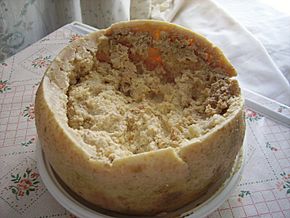Casu martzu facts for kids
Quick facts for kids Casu martzu (Sardinian)Casgiu merzu (Corsican) Rotten cheese |
|
|---|---|
 |
|
| Country of origin | |
| Region, town | |
| Source of milk | Sheep |
| Pasteurised | No |
| Texture | Soft |
| Aging time | 3 months |
| Certification | None |
| Named after | Lua error in Module:Wikidata at line 70: attempt to index field 'wikibase' (a nil value). |
Casu martzu (which means 'rotten cheese') is a special kind of sheep milk cheese from Sardinia, an island in Italy. What makes it unique is that it contains live insect larvae, also known as maggots!
This cheese is a bit like Pecorino cheese, but it goes through a much deeper process. Tiny cheese flies lay their eggs in the cheese. When the eggs hatch, the maggots start eating the cheese. Their digestion helps break down the cheese's fats. This makes the cheese very soft and creamy. It also creates a liquid called làgrima, which means "teardrop" in Sardinian. The maggots themselves are small, clear-white worms, about 8 millimeters long.
A similar cheese is also made in Corsica, a French island. There, it's called casgiu merzu.
How Casu Martzu is Made
To make Casu martzu, a whole Pecorino cheese is left outside. Part of its hard outer layer (rind) is removed. This allows cheese flies, specifically Piophila casei, to lay their eggs inside. A single female fly can lay over 500 eggs at once!
Once the eggs hatch, the tiny maggots begin to eat their way through the cheese. The special acids in the maggots' digestive system break down the cheese's fats. This process makes the cheese incredibly soft and creamy. By the time the cheese is ready to eat, it can contain thousands of these small maggots.
Eating Casu Martzu
Many people in Sardinia believe that Casu martzu is only good to eat if the maggots are still alive. If the maggots have died, some think the cheese is no longer safe. However, if the cheese has been kept in a refrigerator, the maggots might die, and it can still be eaten.
When the cheese is ready, it's often cut into thin pieces. People usually spread it on a special Sardinian flatbread called pane carasau. It's often enjoyed with a strong red wine like cannonau.
One interesting thing about eating Casu martzu is that the maggots can jump! If they are disturbed, they can leap up to 15 centimeters (about 6 inches) away. Because of this, people often hold their hands over their sandwich while eating to stop the maggots from jumping out.
Some people prefer not to eat the maggots. If you don't want to eat them, you can put the cheese in a sealed paper bag. The maggots will try to jump around inside the bag because they can't get enough oxygen. When you no longer hear them jumping, it means they have died, and the cheese can then be eaten.
Similar Cheeses Around the World
While Casu martzu is famous, other cheeses like it are made in different places.
In Italy, you can find similar cheeses in various regions:
- Bross ch'a marcia in Piedmont
- Cacie' Punt in Molise
- Casu puntu in Salento (Apulia)
- Casu du quagghiu in Calabria
- Gorgonzola coi grilli in Liguria
- Frmag punt in Apulia
- Furmai nis in Emilia-Romagna
- Marcetto or cace fraceche in Abruzzo
- Salterello in Friuli Venezia Giulia
Other parts of Europe also have traditional cheeses that use live arthropods (like insects or mites) to help them age and get their unique flavor. For example, the German Milbenkäse and the French Mimolette both use cheese mites.
There's also a similar cheese called Mish made in Egypt.
Even the famous Stilton cheese from England might have had a similar history. In 1724, a writer named Daniel Defoe mentioned that Stilton cheese was served with "mites or maggots round it, so thick, that they bring a spoon with them for you to eat the mites with, as you do the cheese." This shows that eating cheese with small creatures was not always uncommon!
See also
 In Spanish: Casu marzu para niños
In Spanish: Casu marzu para niños

